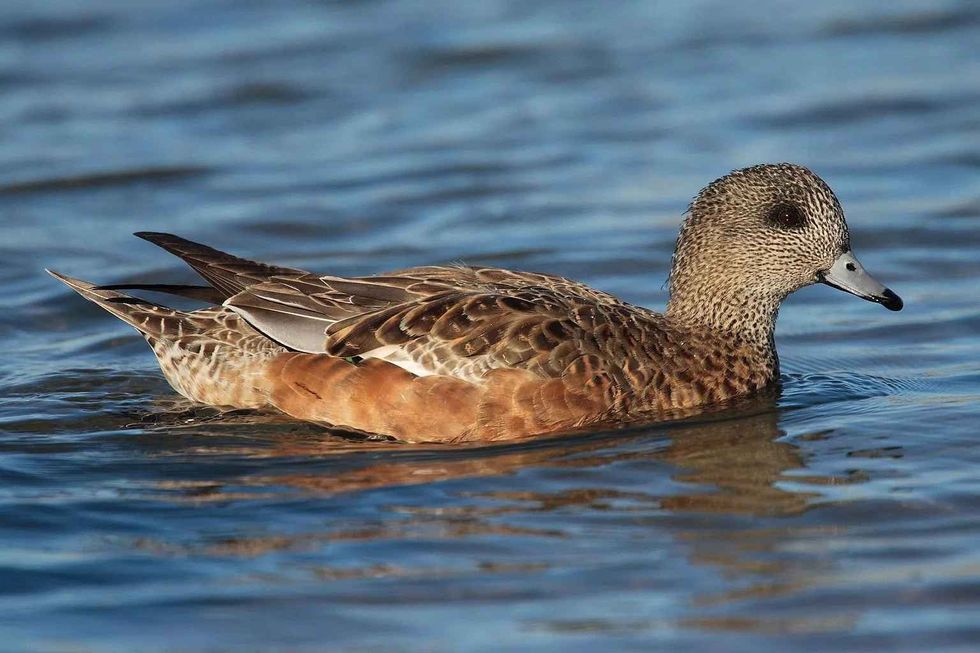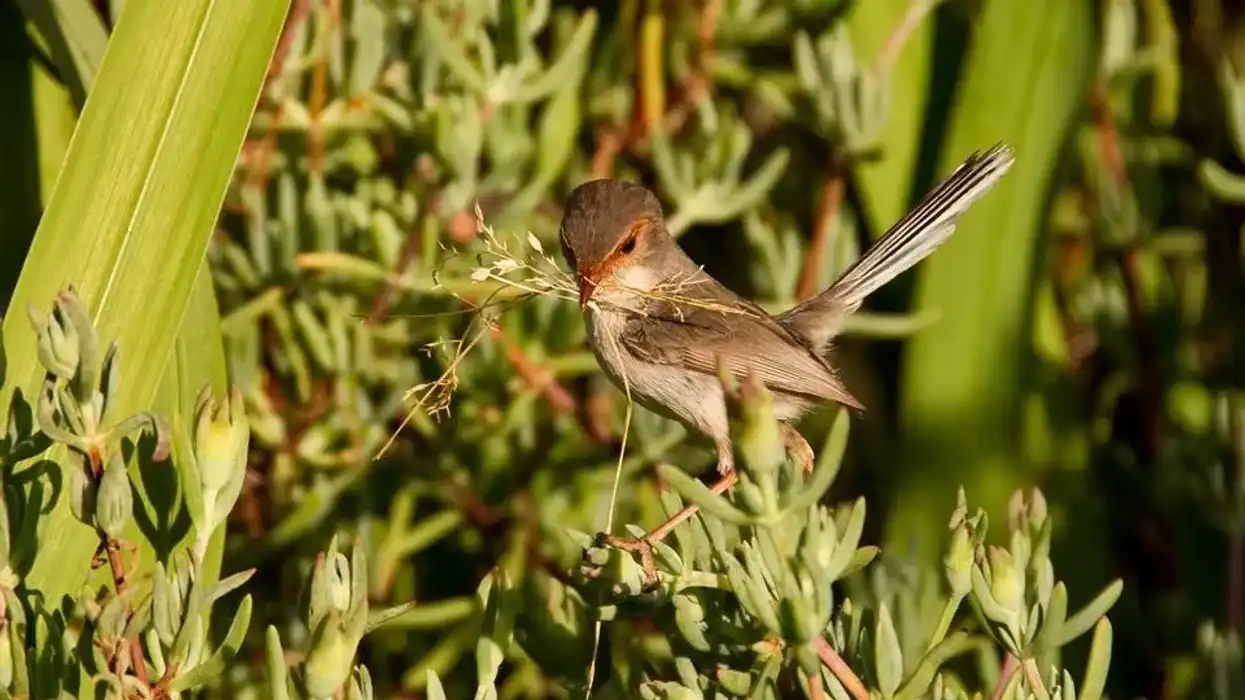The American wigeon (Mareca Americana) or maraca Americana was also called Anas Americana. They are medium-sized dabbling ducks with rounded heads and short bills.
When in water, American wigeons (Mareca Americana) seem to like sitting on it with their heads pulled down to give us the notion that they have no neck. These birds of North America are also called baldpate and have a European counterpart called the Eurasian wigeon.
Mareca means a small duck in Brazilian- Portuguese, which comes from the word ‘marreco’. The male American wigeon has a recognizable patch of green feathers around its eyes and a cream-white crown on its head towards its bill.
Males are known as baldpate due to this feature of theirs. Their underbelly is also white.
These birds of North America also have a white patch on their shoulder, which can be easily recognized when they are in flight. The female American wigeon is less colorful and has brown or gray plumage.
These dabbling ducks both have pale blue bills with black tips, gray legs, and feet. It nests on the ground near the water, and it is hidden. These diving ducks will flock with other species like the American coots.
birds of North America are known as noisy species and have distinctive calls. They are migrating birds that will fly south when northern marshes begin to freeze. After reading these interesting American wigeon duck facts, do check out our other articles on the moorhen and the Muscovy duck.
American Wigeon Interesting Facts
What type of animal is an American wigeon?
American wigeon (order Anseriformes, family Anatidae) is a type of bird or a duck, which can swim on the water, walk on the ground and also fly. The American wigeon's scientific name is Mareca Americana. They are commonly found in the northern, central, and South American regions of marshes and wetlands.
What class of animal does the American wigeon belong to?
The American wigeon ducks belong to the Aves class of animals as these dabbling ducks build their nest on the ground and lay eggs.
How many American wigeons are there in the world?
The American widgeons are found throughout their range, and their population is said to be stable and increasing. However, the birds do suffer due to encroachment, loss of habitat, climate change, and hunting pressure.
These diving ducks are the fifth most harvested ducks in the United States. Their population could be around 1.4 million. The preferred habitat of this species includes rivers, ponds, and marshes.
Where does an American wigeon live?
These North American birds are spread from the tips of Alaska and Canada to the south from Mexico to the northernmost parts of South America. The winter population of these seasonal migratory birds is found in the lower 48 states of the United States and all of Mexico.
The population of this dabbling duck species is not found in the mountainous range of the Rocky Mountains and Appalachian ranges.
Their breeding grounds are across western Canada and almost all of the northwestern United States. During the winter a major population of birds will migrate to Western Europe, especially to Great Britain and Ireland.
What is an American wigeon's habitat?
The American wigeon's habitat can be found in the wetlands of the Boreal Forest and subarctic river deltas of Canada and Alaska. During the winter, they are found in intertidal and lacustrine areas where flora and fauna are in abundance.
These dabbling duck species are found in freshwater marshes, lakes, rivers, saltwater bays, estuaries, and agricultural lands. During the breeding season, they prefer the grounds near the water body with thick vegetation cover, like marshy sloughs.
Mixed grass and short grass prairies are their preferred grounds for breeding. These birds are amongst the earliest water birds that reach their wintering grounds in the US and Canada.
Who do American wigeons live with?
American wigeons form a large congregation most of the time in a year. These North American birds migrate in smaller groups or mixed flocks. They will join mallards, gadwalls, American coots, and others during their fall migration. These birds are amongst the first North American birds to reach their wintering grounds.
How long does an American wigeon live?
The lifespan of the American wigeon is 1.7 to 3 years. However, due to regular hunting activities, they may not live to the higher side of the lifespan. A female American wigeon has an average lifespan of 1.7 years, and for a male, it's 2.3 years.
How do they reproduce?
The male and female American wigeon will start pairing before the start of fall as wigeons migrate to their breeding or wintering grounds. Their breeding season is affected by habitat quality and the availability of food on these grounds.
The breeding range for wigeons is in Alaska and western Canada. The females will select a nest site that is well hidden under the dense growth near the source of water.
Nests are found in the areas of tall grass, and food supply is also abundant in this area. The nests are made of grasses and weed stems and lined with down.
The female will lay up to 12 eggs after the incubation of 25 days during the breeding season. The females take care of the eggs by spending 90% of their time in the nest.
The males are with the female for only two weeks after the eggs are laid. These aquatic birds spend most of their time in water around the nest.
The younger ones are precocial and can leave the nest after 24 hours with their mother. The young ones will feed by dabbling or off the surface.
What is their conservation status?
As their population is known to be stable and set to increase, their conservation status is presently listed as of Least Concern. There is a decline in population due to encroachment, loss of habitat, climate change, and hunting pressure, so some attention to their conservation is warranted.
American Wigeon Fun Facts
What do American wigeons look like?

The male American wigeon has a white crown and forehead and a dark green patch around its eyes and nape. The bill is bluish-gray with a black tip. The rest of the face, neck, and upper back are white with black specks.
The flanks and breasts are reddish-brown, and the underside is white. The female American wigeon has a brownish-black crown with cream and white streaks.
The rest of the upper body with the neck and face is whitish with heavy streaks. The back is grayish-brown with a light bar. Their flanks and undersides are the same as the males.
How cute are they?
The American wigeon bird can be identified as a cute and colorful creature. Along with the ducks, geese, and swans, who are mostly white-colored, the American wigeon in flight stands out for being colorful.
How do they communicate?
Any particular American wigeon sound can be identified by its distinctive calls. The males can produce a three-note whistle, and the female can make hoarse grunts or quacks.
How big is an American wigeon?
The American wigeon has a length of 17-23 in and its wingspan is 30-36 in. Birds of this species are larger than a green-winged teal but smaller than a mallard or a pintail. They are medium-sized compact aquatic birds.
How fast can an American wigeon fly?
The American wigeon flying speed is 15 mph with a top speed of 45 mph. These are migratory birds who travel far and wide in their region and therefore must have great speed to do so.
How much does an American wigeon weigh?
The American wigeon range of weight is 1.1-2.9 lb. Birds of this species are compact medium-sized birds that can swim, walk and fly.
What are the male and female names of the species?
American wigeon males and females have separate names dedicated to them. An American wigeon male is called an American wigeon drake and an American wigeon female is called an American wigeon hen. The males are also called baldpates because of the white patch on their crowns.
What would you call a baby American wigeon?
The American wigeon baby duck is called juvenile American wigeon.
What do they eat?
Their diet comprises aquatic plants like musk grasses, sedges, pondweeds, eelgrass, wild celery, and algae, some snails and insects like caddisflies and damselflies, or terrestrial insects like beetles. On land, their diet includes young grass shoots, seeds, and waste grains which they consume with their short bill.
These birds are found in shallow, freshwater wetlands, mudflats, marshes, ponds, and slow-moving rivers, which are all potential areas for foraging. The stems and leafy parts of aquatic plants also form a part of their diet.
Are they friendly?
The American wigeon is a social animal that lives in large congregations and migrates in smaller groups of varied birds. They are normally found living together and being noisy. However, humans, they may be a little wary as they are hunted by them.
Would they make a good pet?
They are the fifth most harvested ducks in the United States. This species is mostly left in the wild.
If you wish to add them to the pet list, it would be a good idea to give them a pond with natural surrounding and enough food to forage through. But they are noisy creatures, and care must be taken of their habitat.
Did you know...
American wigeons are closely related to gadwalls, geese, falcated ducks, and swans.
The American wigeon will alert other members of their congregation to danger by alarm quacks and by rattling their wings.
They follow other migrating birds to steal food from them.
When you compare the Eurasian wigeon and the American wigeon, there are various distinguishing features on the American wigeon that you will notice, such as a white crown and a gray-brown head as compared to the chestnut and buffy head of its Eurasian counterpart.
Why do American wigeons follow other migrating ducks?
The American wigeon will gather around a feeding diver or coot to steal food from them. They are known to grab food from these diving birds. They are known as poachers or grabbers for this very reason.
How do American wigeons communicate with each other?
The males can produce a three-note whistle, and the female can make hoarse grunts or quacks. When disturbed, they may quack and fly away erratically by rattling their wings.
Here at Kidadl, we have carefully created lots of interesting family-friendly animal facts for everyone to discover! Learn more about some other birds including the blue and yellow macaw and the duck-billed platypus.
You can even occupy yourself at home by drawing one of our American wigeon coloring pages.










